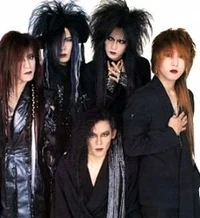
LUNA SEA. Long, spiky hair, accessories, and makeup form the basis of Visual kei fashion
Visual-kei artists are easily identified by their outward appearance, consisting of shaggy or spiky anime-esque hair, gothic or punk-inspired attire, make-up, and accessories; traits that form the basis of the archetypal "VK" (Visual-kei) look. However, like the music, the style has no limits. Visual-kei fashion draws influence from a wide variety of well-established fashion styles, and can range from the subtle to the extreme.
Fashion[]
Hair[]
Many VK artists have dyed hair, often colored red, brown, blonde, or even blue. VK artists also opt for straightened hair, as it allows for a wide variety of hairstyles. Layered cuts have become the norm, as it makes the hair easier to style and maintain. The hair is often flipped out, curled, shaped into tufts, or moulded into spikes, and is usually backcombed/teased to ensure a soft, loose, and feathery look that would allow the hair to flow but retain its shape, even while headbanging. Visual kei artists may also opt for extensions. Punk hairstyles like mohawks, fanned hair, devilocks, and liberty spikes are also employed, especially by older bands such as X JAPAN and BUCK-TICK. Mainstream artists opt for looser, more natural styles such as side-swept emo-bangs or slicked-back surfer hair. Some visual-kei metal artists wear long, thick dreadlocks, a notable example being Ruki of The GazettE. In some cases, visual-kei artists may not style their hair at all, instead, they may let their hair fall freely or have their hair heavily textured for a shaggy, messy look.
Clothing and Image[]
Visual-kei fashion is characterized by individuality, aesthetic appeal and different clothing combinations. Visual-kei fashion is based around an eclectic fusion of rock, punk, metal, and contemporary fashion, however, there are very few, if no rules or limits at all, as to what visual-kei artists can wear, and it is very common among the subculture for artists to experiment with different fashion styles. Common outfit choices include vests, formal suits, skinny jeans, jackets, capes, and coats. Bondage gear and leather clothes are popular choices as well. Some bands, wear anime-inspired attire, even going as far as wearing costumes.
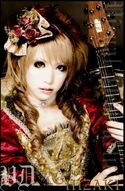
Hizaki of Versailles, one of the most know femenine-looking Visual Kei artists.
Visual-kei puts a huge emphasis on artistic freedom, shock value, and metro-sexual aesthetics. It is a unisex style, and as such, many artists opt for an androgynous look, which adds shock value and fan appeal. Male artists in visual-kei often have lean, slender figures to fit the demands of the style, and it is not uncommon for male artists to adopt a semi-feminine appearance, complete with long, stylish hair and feminine-looking attire. It is quite popular among visual-kei artists to cross-dress or take an entirely feminine appearance, with examples like HIZAKI and the late Jasmine You of Versailles, Mana of Moi Dix Mois (ex-MALICE MIZER), Isshiki Hiyori of Kiryu and, formerly, Toshiya and Shinya of Dir en grey.
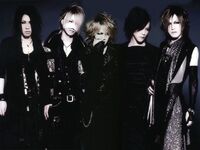
The GazettE
On the other end of the spectrum, VK bands such as The GazettE opt for more aggressive stylings, characterized by dark, inspired clothing, spiky hair, pale/natural-looking make-up and a more punk/metal image.
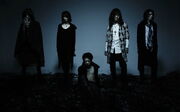
Dir en grey, an extreme metal band associated with the VK movement, showing a rugged image similar to western death metal acts.
Some bands, especially major acts may go for a more toned-down, semi-casual visual approach. Many acts also opt for a more westernized appearance, often done through the use of minimal make-up, unstyled hair, and western outfits such as business suits, military uniforms or jackets. Extreme metal acts such as Dir en grey take it a step further, dropping most, if not all, of the flamboyant attire, heavy makeup, and androgynous aesthetics in favor of a highly distressed, shocking, and rugged look similar to western death metal or black metal bands.
Generally, the clothing choices of visual-kei artists and musicians are based around, if not directly inspired, by their musical stylings. This is observable in long-running bands that undergo multiple musical changes, as they would change their appearance to match the current style of their music.
Main Sub-genres[]
Angura-kei (アングラ系)/Chikashitu-kei (地下室系)[]
"Angura-kei" or "Chikashitsu-kei", (both meaning underground style) usually rejects the androgynous beauty of the mainstream visual-kei bands, and mostly features scary or disturbing aesthetics and themes. Sometimes called "Eroguro-kei" (エログロ系) or "Misshitsu kei" (密室系). The term is said to have been taken from the cali≠gari event Tokyo Chikashitsu ("Tokyo Underground").
Many bands use to wear corpse-paint-like make-up (inspired by the Japanese kabuki tradition), and their concepts are often connected to the Japanese late Taisho and early Showa imagery (first half of the 20th century) or "eroguro" literature and cinema.
Due to their differences with traditional visual-kei bands, it has been debated whether these bands actually belong to the visual-kei culture or not. Several bands described themselves as not being visual-kei, but are still considered to be part of the movement by most fans.
Representative angura-kei bands are cali≠gari, Mucc, Inugami Circus-dan and グルグル映畫館.
Kote-Kei (コテ系)[]
Kote-kei (old school) usually refers to the original visual-kei bands of the early and mid 90's, and later, bands emulating their styles. It is usually colorful and shocking; characterized by wild hair, exotic attire, heavy use of enamel and accessories. Even though kote-kei was originally referring to the glam-rock inspired style of early X JAPAN and COLOR, it is now mostly connected to the dark and decadent looks of mid-90's bands like early LUNA SEA, Kuroyume and Dir en grey.
Bands from the indie labels Matina and Soleil can be cited as the clearest example of kote-kei sound and aesthetics. Bands inspired by Kuroyume were often called "kuro-kei" (black) or "dark-kei", while bands closer to the melodic and atmospheric sound and looks of early LUNA SEA were called "shiro-kei" or "white-kei". Due to their extreme visuals, kote-kei bands receive little attention by mainstream audience and rarely get major debuts. Representative kote-kei bands are DAS:VASSER, La'Mule , Phantasmagoria and Madeth gray'll.
Tanbi-kei (耽美系)[]
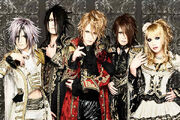
A picture of Versailles, a popular tanbi-kei band.
Drawing inspiration from classic European fashion, tanbi-kei meaning "aesthetic school" is a subset of Kote-kei that adds a more elegant, formal and neoclassical twist to the visual-kei look. It is often cited as an influence to the Japanese gothic-lolita fashion trend.
Even though it started as a more baroque version of the trademark "old school visual-kei sound", many bands started adopting a highly technical style much closer to power and symphonic metal in recent years, with symphonic arrangements, complex guitar solos and long instrumental interludes. Tanbi-kei is also notable for having an abundance of male-to-female cross-dressers and extravagant stage settings.
Because of its easily recognizable image and the elaborated costumes, it is one of the most popular visual-kei styles among cosplayers.
Original tanbi-kei bands are MALICE MIZER, Raphael and LAREINE, while modern examples maybe D, Versailles and Kaya.
Nagoya-kei (名古屋系)[]
Nagoya-kei refers to bands inspired by Nagoya acts such as Laputa, Kuroyume, Merry Go Round, and ROUAGE. Close to both kote-kei and angura-kei, these bands usually wear black clothes and dark, disturbing makeup. Songs are known for their dark and decadent atmospheres, and can be both slow and fast paced.
Kote-kei and Nagoya-kei are often confused, but while kote-kei is known for its raw and unpolished sound, recent Nagoya-kei bands feature a refined and experimental music, sometimes reminiscent of American and European alternative rock. Another difference with kote-kei is the rare use of colors; while kote-kei usually features vivid hair colors and enamel outfits, Nagoya-kei bands are more mature and toned down look. Bands that wear black suits, and light hair colors are considered rare.
Modern Nagoya-kei examples can be Lynch., deadman and 9GOATS BLACK OUT.
[]
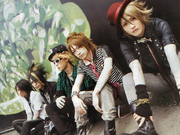
An Cafe, a commercially successful oshare-kei band, showing the toned-down, urban-inspired fashion typical of the Oshare kei movement.
Literally meaning "fashionable style", osare-kei (or "oshare-kei") is a trend focused on light, colorful and appealing aesthetics as opposed to the dark and shocking image traditionally associated with the rest of the movement. Other names for the movement include "pop-kei" and "soft-kei". Being a more mainstream-friendly scene, it has been the fastest-growing visual kei movement in the mid-2000's, and probably one the most popular in recent years. Oshare-kei's sound has more in common with pop and punk than hard rock and heavy metal, characterized by catchy riffs, fast drumming, which may or may not incorporate dance/jungle beats, electronic sounds and highly melodic singing, which may or may not include screaming. Some bands may incorporate nu metal and hip hop elements such as rapping, sampled sounds, raspy vocals and scratching. Lyrical themes are usually lighter and brighter, often dealing with topics such as love, happiness, positivity.
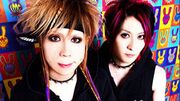
Maya and Aiji of LM.C, showing a darker, more punk-influenced version of the Oshare kei image.
The oshare-kei image is characterized by more casual-looking attire, a stripped-down, contemporary image, anime-inspired haircuts or, with some bands, unstyled hair, and the use of bright colors such as red, yellow, pink, or white. Bands with heavier punk influences may also include black and blue among their color choices. Some bands have crossed over into the kote-kei or nagoya-kei in the form of the so-called "alter-ego bands", a notable example being Ayabie, whose members are involved in a "black visual shock" alter-band called Deathbie.
Some of the most popular and well-received bands in the genre are An Cafe, SuG and LM.C.
Neo-visual / Koteosa[]
As the name says, koteosa is a mixture of kote-kei and osare-kei which had its peak in the mid-to-late 2000's. Bands adopt a fashionable look usually close to the Shinjuku and Harajuku street fashion, and showcase a genre characterized by catchy and mainstream appealing tunes framed into a more aggressive, live-oriented band sound. Koteosa bands usually put a strong focus on the members's look and personality, and have fans perform both furitsuke (choreography, hand movements) and traditional headbanging/moshing at concerts. Popular koteosa bands are The GazettE, Alice Nine and Nightmare.
Soft-visual[]
Soft-visual usually refers to visual-kei bands who were originally old school or tanbi-kei bands but consistently toned down their sound and visuals after gaining popularity. Other soft visual-kei bands do not look or sound like a visual-kei band, but are somehow connected to the visual-kei scene (mostly due to one of the members' past bands or the live houses they usually play concerts at). Soft visual examples are Janne Da Arc, late LUNA SEA and Waive.
Visual-Shock and Neo-Visual Shock[]
Visual shock is essentially where it all began. Visual shock bands employ most of the common visual-kei tropes - gender ambiguity, elaborate outfits, and '80s style glam hair. This style still exists, but has fallen to the wayside in favor of the more recent kote-kei. Neo-visual shock is a recent movement in which bands have been making an attempt to "return to the roots" of the genre. Many visual-shock and neo-visual shock bands play traditional-style heavy metal, but thrash metal and gothic rock are also common genres. More often than not, this is referred to as "visual-kei" without any sort of specification, and is preferred by most. However, "visual shock" can be used to describe certain bands that seem to be prime examples of the style, however, and is useful for this list in particular.
Important visual shock artists include the early careers of X Japan, Luna Sea, and BUCK-TICK.
Other Genres[]
Even though these are the main sub-genres in visual kei, there are many other minor trends usually depending on each band's costume concepts and aesthetics. For example, bands who wear white gowns are called "Iryokei" (医療系 medical style), cyberpunk looking bands are called Cyber-kei, etc.
